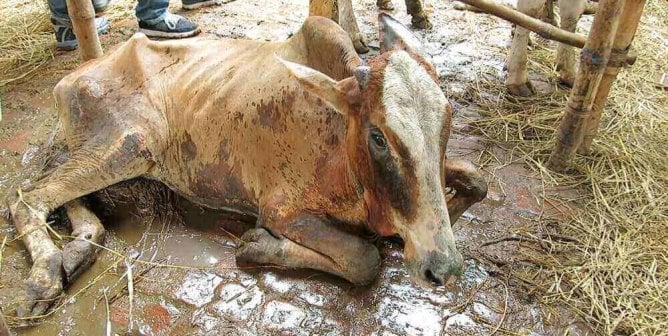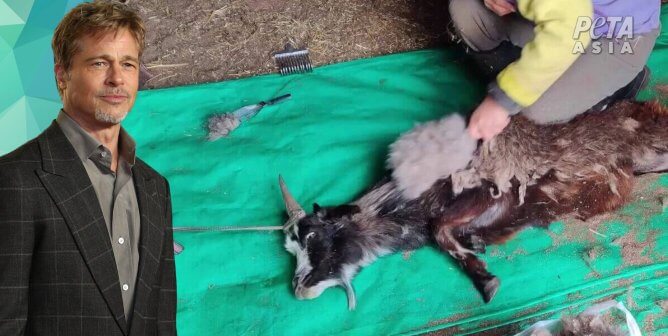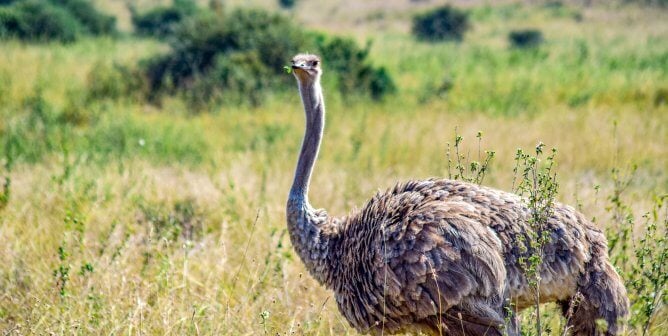Inside the Fur Industry: Trapping Maims and Kills Animals
Although the majority of animals slaughtered for their fur come from notoriously cruel fur factory farms, trappers worldwide kill millions of raccoons, coyotes, wolves, bobcats, opossums, nutria, beavers, otters, and other fur-bearing animals every year for the clothing industry.
How a Trapped Animal Dies
There are various types of traps, including snares, underwater traps, and Conibear traps, but the steel-jaw trap is the most widely used. This simple but barbaric device has been banned or is restricted in a growing number of states across the United States, including Arizona, Colorado, California, and Washington.1 More than 100 countries around the world ban the steel-jaw trap.2 The European Union has banned both the use of the trap and the importation of furs from countries “that catch [wild animals] by means of leghold traps or trapping methods which do not meet international humane trapping standards.”3
When an animal steps on the spring of a steel-jaw trap, the trap’s jaws slam on the animal’s limb. The animal frantically struggles in excruciating pain as the trap cuts into his or her flesh, often down to the bone, mutilating the animal’s foot or leg. Some animals, especially mothers desperate to get back to their young, fight so vigorously that they attempt to chew or twist off their trapped limbs. This struggle may last for hours. Eventually, the animal succumbs to exhaustion and often exposure, frostbite, shock, and death as well.
If trapped animals do not die from blood loss, infection, or gangrene, they might be killed by predators. To prevent this, pole traps are often used. A pole trap is a form of steel-jaw trap that is set in a tree or on a pole. Animals caught in these traps are hoisted into the air and left to hang by the caught appendage until they die or the trapper arrives to kill them.
Conibear traps crush animals’ necks, applying 90 pounds of pressure per square inch. It takes animals three to eight minutes to suffocate in these traps.4 Victims of water-set traps, including beavers and muskrats, can take more than nine agonizing minutes to drown.5
‘Accidental’ Victims
Every year, dogs, cats, birds, and other animals, including endangered species, are crippled or killed by traps. New Mexico veterinarian Dr. Collin Wolf wrote in a letter to Congress that, “(t)hese bone-crushing devices are inherently indiscriminate and inhumane,” and that in his home state, “(t)here have been an exasperatingly large number of reports of trap-related injuries to non-target animals, including cats, dogs, and humans.”6
Trappers call these animals “trash kills” because they have no economic value. State regulations on how often trappers must check their traps vary from 24 hours to one week. In South Carolina, steel-jaw traps can be used without a license, with the only stipulation being that traps must be checked at least once daily. And that’s where a dog named Delilah suffered for at least five days after a trap snapped down on her leg and rescuers struggled to catch and help her. Once she was finally caught, her leg had to be reconstructed.7 In Pittsburg, veterinarians amputated the leg of a Lab mix named Nittany after she was caught in a trap for hours.8
A trapped placed illegally in a Missouri public park snapped on sheltie-mix Ria’s paw as she walked along with her guardian, Michelle Bautista. “It was one of the worst experiences we ever had,” Bautista told the Kansas City Star. “She was struggling and screaming. She could have lost her foot because it literally cuts off the blood supply.”9
Animal Populations Self-Regulate
Contrary to fur-industry propaganda, there is no ecologically sound reason to trap animals for “wildlife management.” In fact, trapping disrupts wildlife populations by killing healthy animals needed to keep their species strong, and populations are further damaged when the parents of young animals are killed. Left alone, animal populations can and do regulate their own numbers. Even if human intervention or an unusual natural occurrence caused an animal population to rise temporarily, the group would soon stabilize through natural processes no more cruel, even at their worst, than the pain and trauma of being trapped and slaughtered by humans.
What You Can Do
Compassion is the fashion! You can discourage trapping by discouraging fur-wearing. When you see people in fur, tell them the facts about trapping; many people incorrectly assume that fur-bearing animals are killed humanely. If you already own a fur garment, please consider giving it to PETA as a tax-deductible donation for use in educational displays, anti-fur demonstrations, and fur giveaways to the homeless. Write or call businesses that sell furs or give furs away as prizes, and ask them to stop promoting cruelty. Ask your legislators to introduce bills to ban trapping. Contact PETA for literature that will inform others about the inherent cruelty of the fur industry. Find out how PETA saves animals.
References
1Carla Field, “Rescue of SC dog with foot crushed in metal coyote trap goes viral,” WYFF, 26 Mar. 2018.
2Global Legal Research Directorate, “Laws on Leg-Hold Animal Traps Around the World,” The Law Library of Congress, Aug. 2016.
3The Commission of the European Communities, “Commission Regulation (EC) No. 35/97 of 10 January 1997 Laying Down Provision on the Certification of Pelts and Goods Covered by Council Regulation (EEC) No. 3254/91,” Official Journal L 008 (1997): 0002-4.
4Tom Reed, “Is Trapping Doomed?” High Country News 12 Apr. 1999.
5John W. Ludders et al., “Drowning Is Not Euthanasia,” Wildlife Society Bulletin 27 (1999): 666-70.
6Dr. Collin Wolf, DVM, Letter to Senator James Inhofe and Senator Barbara Boxer, 16 Jan. 2016.
7Field.
8Mike Hendricks, “Couple’s dog gets caught in steel trap set in Jackson County park,” Kansas City Star, 26 Jan. 2017.
9Ibid.








